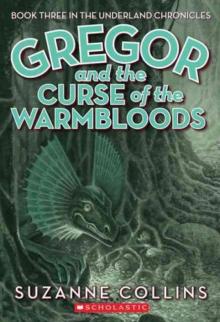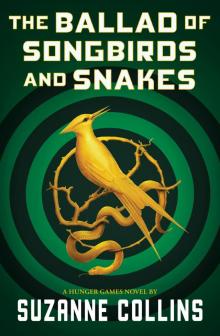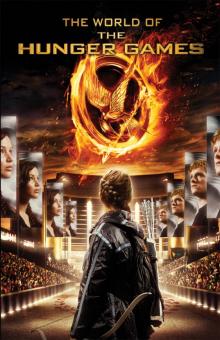- Home
- Suzanne Collins
The World of the Hunger Games Page 2
The World of the Hunger Games Read online
Page 2
There’s an obstacle course, to test the tributes’ strength and reflexes. And there are targets for practicing with knives and spears. These have human faces . . . just like the targets they’ll face in the arena. Every once in a while, there’s that stark reminder of what they’re here for. Training isn’t about getting stronger for its own sake. It’s about preparing to kill, and preparing to die, on a national broadcast.
Some of the tributes are intimidating, while others seem almost nice. But Katniss is always aware that in the arena nobody will really be a friend.
The Training Center echoes with the sound of clanging weapons. But it also fills with a strange sort of hope, for, with every new skill gained, each tribute starts to believe — against all logic — that he or she might be the lucky one to come out of the arena alive.
It’s an entirely false hope implanted by the Capitol to ensure that the Games are especially entertaining.
In past years, the Capitol has unleashed some of its most terrifying muttations, or genetically altered animals, at the Hunger Games. The arena is the best place to showcase what science and technology can do to keep Panem’s people in their proper place. Muttations are intended to be intimidating and often lethal.
Tracker jackers are genetically altered wasps, programmed to kill anyone who disturbs their nest. They’re bigger than regular wasps, and their stings raise huge welts on the skin, roughly the size of plums. Tracker jacker venom creates hallucinations, even madness.
Wolf mutts are part human, part wolf. What makes them terrifying is that their human DNA comes from tributes in the Hunger Games. They can walk on their hind legs and jump extremely high, slashing with their four-inch claws. They are deadly, furious beasts.
Once in a while, though, nature interferes with the Capitol’s plans.
During the rebellion, the Capitol developed jabberjays — birds that could memorize and repeat human conversations — to use as spies. The rebels turned the birds against the Capitol by deliberately telling them lies.
Soon jabberjays were no longer useful to the Capitol, but those remaining created a new species when they mated with mockingbirds. Mockingjays can pick up songs very quickly and relay them back. In District 11 they’re used to pass signals along through the orchards. The mockingjays are not mutts, exactly, and they’re not dangerous. They’re just . . . surprising.
Inside the arena, the tributes will face many challenges.
Some are designed by the Gamemakers to separate the strong tributes from the weak. Some are designed to exploit tributes’ characteristics and flaws. And all are designed to make sure the Capitol audience has an enthralling show to watch.
The Gamemakers aim to entertain the audience and create a spectacle that sponsors will want to be involved in. “Natural” disasters and terrifying mutts are par for the course.
Seneca Crane has his eye on Katniss, an entirely new kind of tribute. She comes from a poor district, so she hasn’t been trained. The Careers have been training all their lives in special schools for this moment, and Katniss shouldn’t stand a chance against them.
Yet she has that spark. She has that natural ability, sharpened by her time in the woods. The audience is drawn to her. Panem is rooting for an underdog!
At Seneca’s direction, many of the obstacles are used to engage and showcase Katniss for the viewers back home. Suddenly, she’s a star, and Seneca wants to make the most of her celebrity.
Only President Snow is thinking about what message it sends to the districts if, for once, the underdog actually wins.
He is keenly aware of the purpose of the Games: to keep the districts in line. An underdog is fine, in her place. But an underdog rising to the top is a different story altogether. A dangerous model for the districts. Somebody who must be destroyed . . . before it’s too late.
Katniss’s difficult life has made her practical and hard. Other girls her age might wonder about love, but Katniss isn’t one of them. She doesn’t have time for that. She’s too busy looking for her family’s next meal.
You wouldn’t say she was cold, when she has such fierce love for her sister, such deep trust in her friend Gale. Gale is her best friend, her equal partner. With him, Katniss has a comfort and a trust she shares with nobody else. She never even thinks of wanting more. But she’s wary of people, generally, and she’s closed off to the possibility of romance in her life. Until — of all things — the Hunger Games begin to open her heart to new possibilities. When suddenly she has to say good-bye to Gale, she wonders for a moment . . . what could have been?
The Hunger Games are confusing on many levels. Katniss is constantly observed, judged, and exploited. She has to negotiate the Capitol’s temptations and the arena’s deprivations. Her emotions are on public display.
When Peeta tells the whole world he’s always had a crush on her, Katniss assumes it’s just a part of the Games. She is humiliated and angry until Haymitch explains that Peeta has made her look desirable. Katniss can appreciate the practical advantage of that. If Peeta likes her, maybe sponsors will, too.
Midway through the Games, a change in the rules pushes these tributes closer together. Katniss is willing to play by this new decree. As always, she will do what she needs to survive. It doesn’t take her long to realize she will get help from Haymitch if she acts like she and Peeta are in love.
As she cares for Peeta, nursing him back to health, she begins to care in a different way, too. Sometimes she is acting. Sometimes she wonders if Peeta is acting, too. But sometimes they are caught up in something unmistakably honest and real.
In the midst of sheer horror, unfamiliar feelings flicker inside Katniss. But just as the Capitol robs children of their lives, it will also rob her of the sweetness of first love. Her feelings aren’t simple, and they’re not entirely her own. Instead, they’re wrapped up with her own survival and — always — how they will appear to an audience.
Back in the Capitol, the show goes on. Though they’ve left the arena, Katniss and Peeta are still constantly in the camera’s gaze. They are again interviewed by Caesar Flickerman — another performance. Their outfits, their makeup, their loving words — how much is real, and how much is for the audience?
Katniss is reunited with Haymitch. Her mentor. Her partner in crime.
And now Katniss realizes that’s what it is. She’s always known it’s a crime that there are Games at all, of course. But it’s also an unforgivable crime that she has embarrassed the Capitol in such a public way, and at its proudest moment.
When President Snow crowns her as victor, she can see the twist of his false and angry smile.
Katniss will be going home on the train, back to her old life. She’ll see her family — and Gale. But will anything be the same?
This is not an ending. It’s only a beginning. Like a mockingjay, Katniss has survived against the odds, and like a mockingjay, she’s an anomaly. Now the Capitol will be closely watching the heroine it has unintentionally created.
Abernathy, Haymitch: Only living victor from District 12, so is assigned to mentor District 12 tributes in the Hunger Games every year.
Atala: Head trainer in the Capitol’s Training Center. Teaches skills that tributes might find useful in the arena.
Avoxes: People who have committed crimes and had their tongues cut out as punishment. Work as servants in the Capitol.
Buttercup: Prim’s mangy yellow cat. Loved by Prim, but not by Katniss.
Capitol, the: Main city and seat of power in the country of Panem.
Capitol residents: Favor brightly dyed hair and eccentric clothing. Speak in a distinctive accent, with a hissing “s” and ends of sentences rising, as if in question. Enthusiastic spectators of the Hunger Games.
Career Tributes (aka the Careers): Teens who have trained their whole lives, and attended spe
cial schools, in order to compete in the Hunger Games. Those not chosen in reapings volunteer to take the place of those who are.
Cato: Boy tribute from District 2. Career. Huge, ruthless, and wily. Kills Thresh. Is one of the last tributes left standing. Almost devoured by mutts, until put out of his misery by Katniss.
Cinna: Katniss’s stylist in the Capitol, responsible for creating her signature look and identity as the Girl on Fire. Does not look or dress like other Capitol residents. Is quietly simple and kind.
Clove: Girl tribute from District 2. Career. Skilled with knives. Tries to kill Katniss, but is killed by Thresh before she can finish the job.
Cornucopia: The site of the opening battle in every Hunger Games. Futuristic horn of plenty, set in a field and overflowing with weapons that tributes may use in the Games — if they can get them without being killed.
Crane, Seneca: Head Gamemaker in the Seventy-fourth Hunger Games.
Dark Days, the: The long-ago rebellion of the districts against the Capitol.
districts: Twelve areas, each dedicated to a different industry, which surround the Capitol and together make up the country of Panem.
Everdeen family plant book: Large scrapbook containing information about properties of herbs and plants. Katniss uses it for reference while foraging in the woods.
Everdeen, Katniss: Sixteen years old, resident of the Seam, District 12. Head of her family. Volunteers as tribute in the Hunger Games when her sister is chosen. A survivor.
Everdeen, Mr.: Katniss’s father, killed in a mining explosion when Katniss was eleven. Taught his eldest daughter how to hunt and sing.
Everdeen, Mrs.: Katniss’s mother. Fell into a deep depression when her husband died, was unable to care for her daughters. Is better now, but still damaged. Works as a healer.
Everdeen, Primrose: Katniss’s beloved twelve-year-old sister. Chosen as tribute in the Hunger Games, until Katniss steps in to take her place.
Flavius: Member of Katniss’s prep team. Helps with Katniss’s Capitol makeover.
Flickerman, Caesar: Has hosted interviews before and after the Hunger Games for the past forty years. A timeless television personality.
force field: Will repel anything that is thrown at it. One of the Capitol’s means of control.
Foxface: Girl tribute from District 5. Sly and elusive. Dies after poaching and eating nightlock berries.
Gamemakers: The team responsible for designing the arena for the Hunger Games, as well as all of the challenges within it. Control the Games from inside their Capitol headquarters.
Glimmer: Girl tribute from District 1. Career. Flirtatious and sexy. Killed by tracker jackers.
groosling: Wild bird that lives inside the arena, and elsewhere in Panem. A food source for tributes in the Games.
Hawthorne, Gale: Eighteen years old. Katniss’s best friend and hunting partner. Also from the Seam. Father killed in same mining accident that killed Mr. Everdeen. Promises to care for Katniss’s family when she leaves for the Games.
Hob, the: District 12’s black market. Katniss sells game here, sometimes even to Peacekeepers.
hovercraft: Capitol airship. Used to transport tributes to the arena and also to take dead tributes away.
Hunger Games, the: Gladiator games developed by the Capitol to keep the districts in line. Two tributes are chosen from each district, one boy and one girl, between the ages of twelve and eighteen. They are sent to an arena to fight to the death on live TV.
jabberjay: Bird muttation with the ability to memorize and repeat human conversation. Developed by the Capitol to use for spying, but not effective. Rebels fed the birds misinformation.
Justice Building, the: The Capitol’s headquarters in each district.
katniss: Plant that Katniss was named for. A tuber that grows in water. Tall, with leaves like arrowheads.
Lady: Prim’s goat, a birthday gift from Katniss. With Lady’s milk, Prim makes and sells cheese.
Marvel: Boy tribute from District 1. Career. Kills Rue. Killed by Katniss.
Mellark, Peeta: Boy tribute from District 12. Once helped Katniss in a crisis, and neither has forgotten. Baker’s son. Good with words and people. Has always loved Katniss from afar.
mockingjay: Offspring of male jabberjays and female mockingbirds. Can replicate bird whistles and human melodies. An accidental muttation.
muttations: Genetically altered animals developed by the Capitol to use as weapons. Also known as mutts.
nightlock: Wild berries. Highly poisonous.
Octavia: Member of Katniss’s prep team. Helps with Katniss’s Capitol makeover.
Panem: Country of the future, where North America used to be, made up of twelve districts and one great Capitol. Setting for The Hunger Games.
Peacekeepers: The Capitol’s police.
Portia: Peeta’s stylist.
reaping: Method of choosing tributes for the Hunger Games. Boys’ names are in one giant ball, and girls’ names are in another. One name is chosen from each ball, with great fanfare.
Remake Center, the: Where tributes go upon arriving in the Capitol. Here, each tribute is given whatever trimming, shaving, tweezing, or polishing seems necessary, then presented to a stylist.
Rue: Girl tribute from District 11. Small, fast, and agile. Katniss’s ally and heartbreak in the arena. Killed by Marvel, setting the stage for Katniss’s rebellion.
rue: Small yellow flower that Katniss has seen in District 12.
Seam, the: A shabby neighborhood in District 12, home to many coal miners and their families, including the Everdeens.
silver parachute: Method of sending gifts from Capitol sponsors to tributes in the arena.
Snow, President Coriolanus: President of Panem. Looks kindly and gentle, but is actually brutal and cruel.
Templesmith, Claudius: Longtime announcer for the Hunger Games, along with Caesar Flickerman.
tessera: Purchased by desperate people in the districts. A child can obtain an extra supply of food or oil for his or her family . . . by putting his or her name in the reaping an extra time.
Thresh: Boy tribute from District 11. A gentle giant. Kills Clove because he thinks she killed Rue. Lets Katniss go because of her ties to Rue. Is killed by Cato.
token: Memento taken by tributes into the arena. Usually a reminder of home.
Training Center, the: Where tributes learn the skills they will need to fight — and perhaps survive — in the arena.
tracker jackers: Genetically altered wasps whose sting contains a dangerous venom that causes hallucinations and even death.
Treaty of Treason, the: Ended the rebellion of the districts against the Capitol, setting up the Hunger Games.
Trinket, Effie: Conducts the reaping for District 12 every year, and escorts the district’s tributes to the Capitol. Manically upbeat and outlandishly dressed, she always makes a spectacle in District 12.
Venia: Member of Katniss’s prep team. Helps with Katniss’s Capitol makeover.
Victor’s Village: Where victors live when the Hunger Games are over and they return home. Each district has one. In District 12, only one person lives there.
Victory Banquet: After the Games are over, the victor is honored at this celebration.
Acknowledgments
Many thanks to Yon Elvira, Amanda Maes, and Douglas Lloyd at Lionsgate; to David Levithan, Emily Seife, Erin Black, Lindsay Walter, and Rick DeMonico at Scholastic; and, as always, to the incomparable Suzanne Collins.
— K.E.
* * *
Published by Sch
olastic Australia Pty Ltd
PO Box 579 Gosford NSW 2250
ABN 11 000 614 577
www.scholastic.com.au
Part of the Scholastic Group
Sydney • Auckland • New York • Toronto • London • Mexico City • New Delhi • Hong Kong • Buenos Aires • Puerto Rico
SCHOLASTIC and associated logos are trademarks and/or
registeredtrademarks of Scholastic Inc.
Copyright © 2012 by Scholastic Inc.
Unless otherwise credited, motion picture artwork and photography © 2012 by
Lions Gate Films Inc. All Rights Reserved.
Unit photography by Murray Close.
Cover image courtesy Lionsgate.
Photo of Suzanne Collins by Todd Plitt.
This book was designed by Rick DeMonico and Heather Barber.
First published by Scholastic Press, an imprint of Scholastic Inc.
This electronic edition published by Scholastic Australia Pty Limited in 2012.
E-PUB/MOBI eISBN 978-1-921-98845-5
All rights reserved. No part of this publication may be reproduced or transmitted in any form or by any means, electronic or mechanical, including photocopying, recording, storage in an information retrieval system, or otherwise, without the prior written permission of the publisher, unless specifically permitted under the Australian Copyright Act 1968 as amended.

 The Hunger Games
The Hunger Games Catching Fire
Catching Fire Mockingjay
Mockingjay Gregor the Overlander
Gregor the Overlander Gregor and the Curse of the Warmbloods
Gregor and the Curse of the Warmbloods Gregor and the Code of Claw
Gregor and the Code of Claw The Ballad of Songbirds and Snakes
The Ballad of Songbirds and Snakes The World of the Hunger Games
The World of the Hunger Games Mockingjay (The Final Book of The Hunger Games)
Mockingjay (The Final Book of The Hunger Games) The Underland Chronicles: Books 1-5 Paperback Box Set
The Underland Chronicles: Books 1-5 Paperback Box Set The Hunger Games Trilogy
The Hunger Games Trilogy Hunger Games 02 - Catching Fire
Hunger Games 02 - Catching Fire Cathing Fire thg-2
Cathing Fire thg-2 Hunger Games 03-Mockingjay
Hunger Games 03-Mockingjay Hunger Games 2 - Catching Fire
Hunger Games 2 - Catching Fire Hunger Games 01 - The Hunger Games
Hunger Games 01 - The Hunger Games Hunger Games 01-The Hunger Games
Hunger Games 01-The Hunger Games